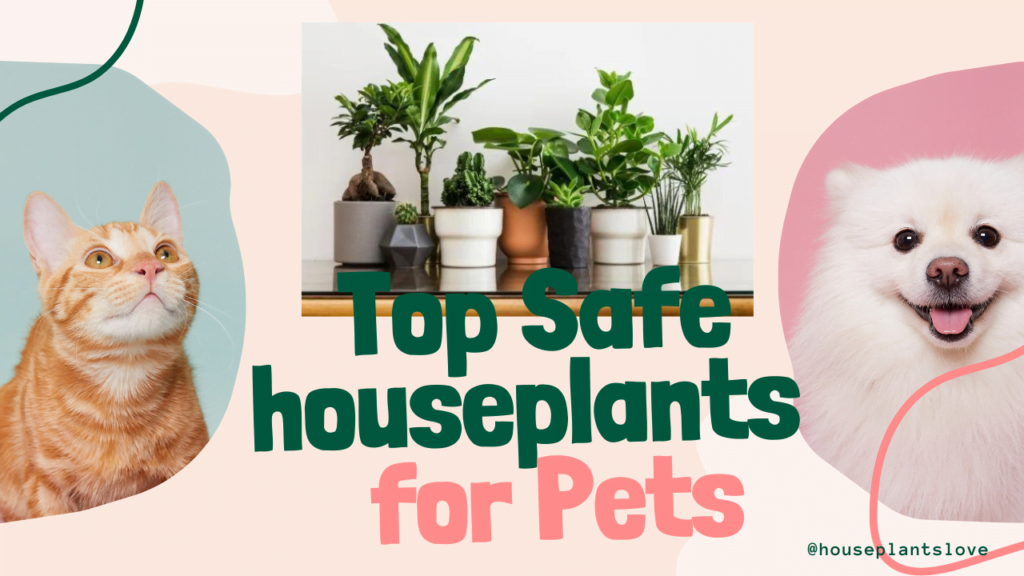Top 10 indoor plants Safe for Cats, Are House Plants Safe for Pets, What indoor plants are toxic or not safe for Pets, Precautions to Keep Pets Safe
Are Indoor Plants Safe for Pets like Cats and Dogs?
Not all houseplants are safe for pets. Some plants can be poisonous to cats and dogs if they ingest them, even in small amounts. Houseplants have lots of benefits for the home but some indoor plants can cause a risk to both cats and dogs if they are toxic and ingested by pets.

While there are many indoor plants that are safe for cats and dogs, there are also several that can be harmful or even toxic to them. It’s essential to be aware of which in-house plants you have in your home and take precautions to protect your pets. Here’s a general guideline:
Top 10 Indoor Plants, Which are Safe for Pets like Cats and Dogs?
For cat and dog owners, it’s crucial to choose houseplants that won’t pose a threat to your feline companions. Some cat and dog-safe indoor plants include:
Spider Plant (Chlorophytum comosum):
Spider Plant is Non-toxic and known for air-purifying qualities.
Areca Palm (Dypsis lutescens):
Safe and adds a tropical touch to your decor.
Boston Fern (Nephrolepis exaltata):
Boston Fern is a lush and cat-friendly option.
African Violet (Saintpaulia):
Colorful blooms without toxicity.
Kentia Palm (Howea forsteriana):
The Kentia palm is another tall, elegant palm tree that is non-toxic to pets. It is also relatively easy to care for, making it a good choice for first-time plant owners.
Pet Grass:
Pet grass is a safe and healthy snack for animals. It is made from wheatgrass or barleygrass, which are both high in fiber and nutrients. Pet grass can help to improve digestion, freshen breath, and relieve constipation. It can also be a source of entertainment for animals, as they enjoy chewing on the grass blades.
Cast Iron Plant:
The cast iron plant is a hardy plant that can tolerate low light and neglect. It is also non-toxic to pets, making it a great choice for pet owners.
Prayer Plant (Maranta leuconeura):
The prayer plant is a colorful and unique plant that gets its name from the way its leaves fold up at night. It is non-toxic to pets, but it does require bright, indirect sunlight.
Banana Plant:
The banana plant is a tropical plant that can grow quite large. It is non-toxic to pets, but it does require bright, indirect sunlight and high humidity.
Parlor Palm:
The parlor palm is a small, bushy palm tree that is perfect for tabletops or small spaces. It is non-toxic to pets and easy to care for.
What Indoor plants are toxic or not safe for Cats?
- ZZ plant: This plant can cause vomiting and diarrhea.
- Lilies: Lilies, especially Easter lilies and Tiger lilies, are highly toxic to cats and can cause kidney failure if ingested.
- Peace Lily: Peace lilies can irritate the mouth and digestive tract of pets, leading to drooling, vomiting, and difficulty swallowing.
- Pothos: Pothos plants contain oxalates that can irritate the mouth and digestive tract of pets. Ingesting pothos can lead to drooling, difficulty swallowing, and vomiting.
- Philodendron: Philodendron plants also contain oxalates and can cause similar symptoms as pothos when ingested by pets.
- Dieffenbachia: Also known as dumb cane, this plant contains calcium oxalate crystals that can cause oral irritation, drooling, difficulty swallowing, and vomiting. if chewed on by pets.
- Snake Plant: Snake plants are mildly toxic and can cause gastrointestinal upset in cats and dogs.
- Aloe Vera: Aloe vera plants can be toxic to pets, causing vomiting and diarrhea if ingested.
- Azalea: Azaleas are highly toxic and can cause severe gastrointestinal symptoms, drooling, and even cardiovascular issues if ingested by pets.
- Sago Palm: Sago palms are extremely toxic to pets and can lead to liver failure, seizures, and even death if ingested.
- Oleander: Oleander is another highly toxic plant that can cause severe cardiac issues and even death if ingested by pets.
To keep your pets safe, consider the following precautions about Indoor House plants
- Research plants: Before bringing a new plant into your home, research its toxicity to pets. There are many resources available online that list toxic and non-toxic plants.
- Keep plants out of reach: Place toxic plants in locations that are inaccessible to your pets. Use hanging planters or shelves to keep plants higher up.
- Monitor your pets: Keep an eye on your pets to ensure they don’t chew or ingest houseplants. If you notice any unusual behavior or symptoms, contact your veterinarian immediately.
- Choose pet-friendly plants: If you want to have houseplants and pets, opt for plants that are known to be non-toxic to cats and dogs, such as spider plants, Boston ferns, or African violets.
Remember that even non-toxic plants can cause mild gastrointestinal upset if ingested, so it’s essential to observe your pets and provide them with appropriate alternatives for chewing and play. If you’re unsure about a specific plant’s safety, consult your veterinarian or a knowledgeable plant expert.
You can also read about Low-Cost, Affordable Winter Plant Protection Tips
You can also read about the Guide to Artificial Lighting for Indoor Plants




